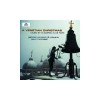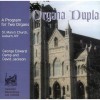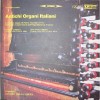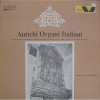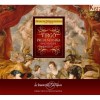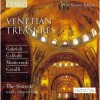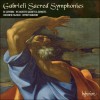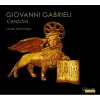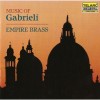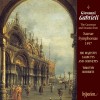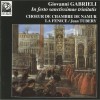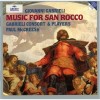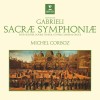| 国家: | 意大利 |
| 期间: | Renaissance, 巴洛克 |
传记
Giovanni Gabrieli (c. 1554/1557 – 12 August 1612) was an Italian composer and organist. He was one of the most influential musicians of his time, and represents the culmination of the style of the Venetian School, at the time of the shift from Renaissance to Baroque idioms.
Gabrieli was born in Venice. He was one of five children, and his father came from the region of Carnia and went to Venice shortly before Giovanni's birth. While not much is known about Giovanni's early life, he probably studied with his uncle, the composer Andrea Gabrieli; he may indeed have been brought up by him, as is implied by the dedication to his 1587 book of concerti, in which he described himself as "little less than a son" to his uncle.[1] He also went to Munich to study with the renowned Orlando de Lassus at the court of Duke Albert V; most likely he stayed there until about 1579. Lassus was to be one of the principal influences on the development of his musical style.[2]
By 1584 he had returned to Venice, where he became principal organist at San Marco di Venezia, also known as Saint Mark's Basilica, in 1585, after Claudio Merulo left the post; following his uncle's death the following year he took the post of principal composer as well. Also after his uncle's death he began editing much of the older man's music, which would otherwise have been lost; Andrea evidently had had little inclination to publish his own music, but Giovanni's opinion of it was sufficiently high that he devoted much of his own time to compiling and editing it for publication.
Gabrieli's career rose further when he took the additional post of organist at the Scuola Grande di San Rocco, another post he retained for his entire life. San Rocco was the most prestigious and wealthy of all the Venetian confraternities, and second only to San Marco itself in splendor of its musical establishment. Some of the most renowned singers and instrumentalists in Italy performed there and a vivid description of its musical activity survives in the travel memoirs of the English writer Thomas Coryat. Much of his music was written specifically for that location, although he probably composed even more for San Marco.
San Marco had a long tradition of musical excellence and Gabrieli's work there made him one of the most noted composers in Europe. The vogue that began with his influential volume Sacrae symphoniae (1597) was such that composers from all over Europe, especially from Germany, came to Venice to study. Evidently he also made his new pupils study the madrigals being written in Italy, so not only did they carry back the grand Venetian polychoral style to their home countries, but also the more intimate style of madrigals; Heinrich Schütz and others helped transport the transitional early Baroque music north to Germany, a trend that decisively affected subsequent music history. The productions of the German Baroque, culminating in the music of J.S. Bach, were founded on this strong tradition, which had its roots in Venice.
Gabrieli was increasingly ill after about 1606, at which time church authorities began to appoint deputies to take over duties he could no longer perform. He died in 1612, of complications from a kidney stone.
Though Gabrieli composed in many of the forms current at the time, he preferred sacred vocal and instrumental music. All of his secular vocal music is relatively early; he never wrote lighter forms, such as dances; and late in his career he concentrated on sacred vocal and instrumental music that exploited sonority for maximum effect. Among the innovations credited to him – and while he was not always the first, he was the most famous to do these things – were the use of dynamics; the use of specifically notated instrumentation (as in the famous Sonata pian' e forte); and the use of massive forces arrayed in multiple, spatially separated groups, an idea which was to be the genesis of the Baroque concertato style, and which spread quickly to northern Europe, both by the report of visitors to Venice and by Gabrieli's students, which included Hans Leo Hassler and Heinrich Schütz.
Like composers before and after him, he would use the unusual layout of the San Marco church, with its two choir lofts facing each other, to create striking spatial effects. Most of his pieces are written so that a choir or instrumental group will first be heard on one side, followed by a response from the musicians on the other side; often there was a third group situated on a stage near the main altar in the center of the church. While this polychoral style had been extant for decades (Adrian Willaert may have made use of it first, at least in Venice) Gabrieli pioneered the use of carefully specified groups of instruments and singers, with precise directions for instrumentation, and in more than two groups. The acoustics were and are such in the church that instruments, correctly positioned, could be heard with perfect clarity at distant points. Thus instrumentation which looks strange on paper, for instance a single string player set against a large group of brass instruments, can be made to sound, in San Marco, in perfect balance. A fine example of these techniques can be seen in the scoring of In Ecclesiis.
Gabrieli's first motets were published alongside his uncle Andrea's compositions in his 1587 volume of Concerti. These pieces show much influence of his uncle's style in the use of dialogue and echo effects. There are low and high choirs and the difference between their pitches is marked by the use of instrumental accompaniment. The motets published in Giovanni's 1597 Sacrae Symphoniae seem to move away from this technique of close antiphony towards a model in which musical material is not simply echoed, but developed by successive choral entries. Some motets, such as Omnes Gentes developed the model almost to its limits. In these motets, instruments are an integral part of the performance, and only the choirs marked "Capella" are to be performed by singers for each part.
There seems to be a distinct change in Gabrieli's style after 1605, the year of publication of Monteverdi's Qinto libro di madrigale, and Gabrieli's compositions are in a much more homophonic style as a result. There are sections purely for instruments - called "Sinfonia" - and small sections for soloists singing florid lines, accompanied simply by a basso continuo. "Alleluia" refrains provide refrains within the structure, forming rondo patterns in the motets, with close dialogue between choirs and soloists. In particular, one of his best-known pieces, In Ecclesiis, is a showcase of such polychoral techniques, making use of four separate groups of instrumental and singing performers, underpinned by the omnipresent organ and continuo.





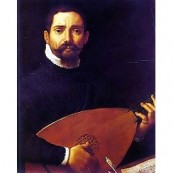

![Christmas Adagios [CD1 of 2]](http://static.classicalm.com/repository/collection-cover/small/1219-img1354498625885822.jpg)
